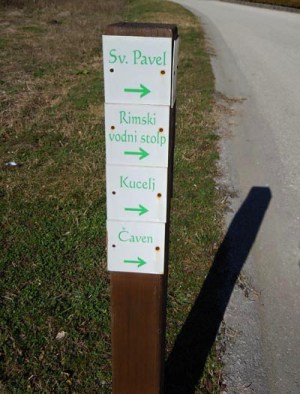
We start from the parking place at Pirjevec, in hamlet Guli, turn into alley and over stream Vrtvinšček. The trail leads us between vineyards through Brdce (altitude 202 meters). After slight descend on beaten path you can stop at Čermelj and to admire the ZOO with horses, donkeys, pigeons, gooses and other animals.
Then follow the markings to riverbed of Vrtovinšček to Kozjak towards Ribičeva power station, which is situated between waterfalls. When the water level oscillates they are of different heights. From here continue along marked path with ascend towards hamlet Kocjani, where is the house, with outdoor stairs and gable, an example of beautiful architecture of Primorska in Vrtovin. Follow the markings to hamlet Lozarji, from where you follow marked path to Roman water tower, which is, with its 11 meters, the highest still preserved Roman building in Slovenia. To heap ascent to St. Paul (altitude 498 meters) is only a few minutes of walk away. If we follow beaten path at the edge we come to the church of St. Paul, main point of this circular path. On Roman road, on eastern slope, we slowly descend towards hamlet Feuči, through chapel to Rebičevi in hamlet Guštini, where we can see a museum with objects from Soča front. Trail takes us into Jama, through stope, which was the last working one in Vrtovin. Almost mandatory is the stop in the village church dedicated to Vrigin Mary that stores one of the most beautiful statues of Gothic plastic in Slovenia, Mary with Jesus in her lap, from second half of 15th century. We also need to point out the caverns – remains of 1st World War, namely on opposite side of monument to fallen in NLS, the work of Marko Pogačnik. In front of the bridge across the stream Vrtovinšček is Černigoj saw, which still works today. Trail leads us towards the initial point.
Time of the walk on circular trail Ortaona is 3-4 hours.
 Map of circular trail Ortaona
Map of circular trail Ortaona
On the map is marked the whole circular path that takes us around attractions of local community Vrtovin. Marked is also a parking space, which is also a starting point of the trail. To view the map in full size, just click on the image on the left or on the link to open it in another window. [_See the map_]
 Vrtovin
Vrtovin
Vrtovin belongs among the most elongated counties in Ajdovščina. It is characterised by reminders of the past that locals included into contemporarily life. Vrtovin is a middle sized village, located north of the main road, which runs through Vipava valley. The territory of Vrtovin is pulled in direction north – south. [_Read more_]
 Homestead 84
Homestead 84
Homestead Vrtovin number 84 is a profane building heritage. Unified homestead with floor residential and economic buildings under gable varicose roof. It is a remarkable sample of folks design in stone and wood – partially bricked and partially wooden Ghanaian, an externally stone staircase. [_Read more_]
 Chapel at Lozarji
Chapel at Lozarji
Chapel is located on a branch towards hamlet Lozarji. It is a monument of sacral character from year 1874. Chapel has pitched varicose roof with the forged cross on a ridge. The portal with repressed arch framed with rustic in plaster and pilaster with profiled capital. [_Read more_]
 Sacral sign before hamlet Kocjani
Sacral sign before hamlet Kocjani
At homestead number 95 stands a sign before hamlet Kocjani, it is a monument of sacral character from year 1903. It is a stone pillar sign, which is compounded by stone base, pillar and house with fourfold roof. In the niche is a statue of Virgin Mary. Acronym on the stone pillar A.C. is short for Anton Copic. [_Read more_]
 Church of Mary the Virgin
Church of Mary the Virgin
Church of Mary the Virgin is located in the center of settlement Vrtovin and is directed towards east. The church was renovated for the last time in year 1897. In the axis follow the trilaterally finished presbytery, which has a preserved Gothic window, and a wider and higher rectangular ship. [_Read more_]
 Monument to the fallen in NLS
Monument to the fallen in NLS
Contribution of Vrtovin in NLS was extensive. Decisive and supreme political activity in 2nd World War was organised from Liberation Front (LF) and to this was devoted the majority of Vrtovin population. Monument to fallen in NLS and to victims of war crimes is the work of Marko Pogačnik. [_Read more_]
 Tomb to the fallen in NLS
Tomb to the fallen in NLS
Tomb of the fallen in National liberation struggle is located in village cemetery in Vrtovin, opposite to church Mary the Virgin, next to the tomb Stibiel – Vukasović. On tombstone are written the names of all the fallen. Beside stated here also rest yet 96 fighters that have fallen under Čaven. [_Read more_]
 Tomb Stibilj – Vukasović
Tomb Stibilj – Vukasović
Tomb Stibilj – Vukasović was made in 1924 in the memory of Stibilj – Vukasović clan, that in Slovenia still has a good repute. It is an incredible story of Janko Stibiel, who joined the rebels in Bosnia. He was accepted in the Serbian army in 1876. In 1912 he became colonel of Serbian royal Army of Monarchy Serbia. [_Read more_]
 Caverns
Caverns
The 1st World War was not able to avoid Vrtovin, therefore here are visible traces from those times in the form of caverns, which were at that time build for the purpose of protection against artillery and air strikes, maybe also as auxiliary warehouses or living units. [_Read more_]

